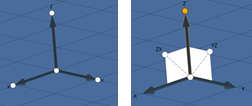Systems
Local coordinate systems can be used for setting up loads/boundary conditions that do not act in the global axis direction, transforming results, defining material orientation, and many other operations.
Create Systems
System Microdialog Options

- Choose between a rectangular, cylindrical, or spherical system.

- Specify the Axis and Plane combinations for the system being created
(X-XY, Y-YZ, Z-ZX). The system can either be node-based (associative) or
coordinate-based (non-associative).Note: The exact conventions shown in the drop-down will vary based on the current solver interface.

- Toggle between reduced (default) and full manipulator modes.

- Align the system manipulator to the global coordinate system.

- Assign an input reference system with respect to which the system will
be defined.Note: Once the input reference system is assigned, the system button is shown with a tick mark
 indicating that an input reference
system is assigned. The assignment is remembered until you exit the
tool.
indicating that an input reference
system is assigned. The assignment is remembered until you exit the
tool.
Manipulator Microdialog Options
 ,
,  ,
, 
- Align the selected system handle to one of the global axes or manually type the vector components.

- Reverse the direction of the system handle.

- Translate or rotate the system with precision.

- Align the system handle normal or parallel to the current view.

- Edit System handle (Origin/Axis/Plane) coordinates.

- Reset the position of the handles to move closer to the manipulator.

- Opens a node selector, which allows you to select the node graphically
or, alternatively, use advanced selection to manually input the node
ID.Note: The grayed-out field next to the node button displays the id of the node that the system handle is snapped to. The node button is shown with a tick mark
 indicating that the handle is snapped
to a model node. If the handle is not snapped to any model node, the
field indicates the same with a “0”, and the manipulator creates a
temp node at the location, thereby allowing the system to remain
valid.
indicating that the handle is snapped
to a model node. If the handle is not snapped to any model node, the
field indicates the same with a “0”, and the manipulator creates a
temp node at the location, thereby allowing the system to remain
valid.
Edit Systems
-
To open the System tool in edit mode, do one of the following from idle:
- Double-click on a System
- Right-click on a System and select Edit from the context menu.
- Select a System, then access the tool from the ribbon icon.
- Utilize any of the actions noted above to modify the System type or orientation.
-
On the guide bar, click
 to confirm the change and
to confirm the change and  to exit the tool.
to exit the tool.
- While in edit mode, you can change the system type using the type and axis-plane drop-downs, and the context automatically handles the conversion of the coordinate system.
- If your model does not contain nodes, use the location selector to pick an origin and modify the (Origin/Plane/Axis) handle coordinates using the microdialog/snaps.
- Refer to the entity status icon on the guide bar for status and feedback. Clicking the icon will fit the view to the current system.
- Changes made in the System tool are automatically committed to the database. If a change is made that invalidates the System (for example, clearing the Origin node), the system will turn gray, and the database will not be updated until the system is made valid again. The entity status icon and error flags on the selectors help identify required inputs.
System Assignment
Systems are available for assignment to properly control the orientation of entities like loads, transformations of parts, model has degrees of freedom for movement during simulation among many other applications.


